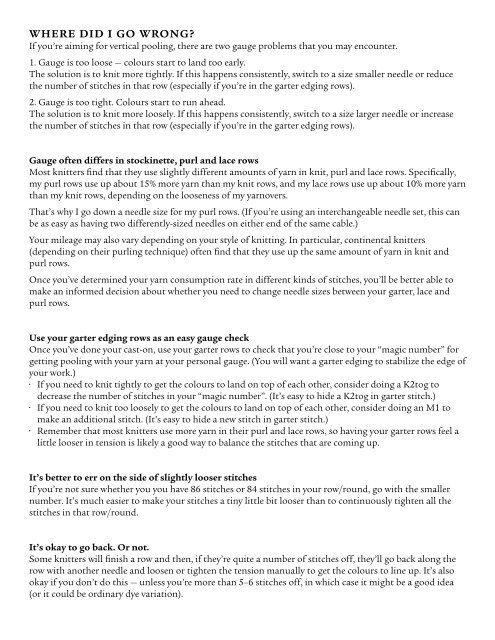Introduction to Planned Pooling - Sock Summit 2011
Introduction to Planned Pooling - Sock Summit 2011
Introduction to Planned Pooling - Sock Summit 2011
Create successful ePaper yourself
Turn your PDF publications into a flip-book with our unique Google optimized e-Paper software.
WheRe dId I go WRong?<br />
If you’re aiming for vertical pooling, there are two gauge problems that you may encounter.<br />
1. Gauge is <strong>to</strong>o loose — colours start <strong>to</strong> land <strong>to</strong>o early.<br />
The solution is <strong>to</strong> knit more tightly. If this happens consistently, switch <strong>to</strong> a size smaller needle or reduce<br />
the number of stitches in that row (especially if you’re in the garter edging rows).<br />
2. Gauge is <strong>to</strong>o tight. Colours start <strong>to</strong> run ahead.<br />
The solution is <strong>to</strong> knit more loosely. If this happens consistently, switch <strong>to</strong> a size larger needle or increase<br />
the number of stitches in that row (especially if you’re in the garter edging rows).<br />
gauge often differs in s<strong>to</strong>ckinette, purl and lace rows<br />
Most knitters find that they use slightly different amounts of yarn in knit, purl and lace rows. Specifically,<br />
my purl rows use up about 15% more yarn than my knit rows, and my lace rows use up about 10% more yarn<br />
than my knit rows, depending on the looseness of my yarnovers.<br />
That’s why I go down a needle size for my purl rows. (If you’re using an interchangeable needle set, this can<br />
be as easy as having two differently-sized needles on either end of the same cable.)<br />
Your mileage may also vary depending on your style of knitting. In particular, continental knitters<br />
(depending on their purling technique) often find that they use up the same amount of yarn in knit and<br />
purl rows.<br />
Once you’ve determined your yarn consumption rate in different kinds of stitches, you’ll be better able <strong>to</strong><br />
make an informed decision about whether you need <strong>to</strong> change needle sizes between your garter, lace and<br />
purl rows.<br />
Use your garter edging rows as an easy gauge check<br />
Once you’ve done your cast-on, use your garter rows <strong>to</strong> check that you’re close <strong>to</strong> your “magic number” for<br />
getting pooling with your yarn at your personal gauge. (You will want a garter edging <strong>to</strong> stabilize the edge of<br />
your work.)<br />
• If you need <strong>to</strong> knit tightly <strong>to</strong> get the colours <strong>to</strong> land on <strong>to</strong>p of each other, consider doing a K2<strong>to</strong>g <strong>to</strong><br />
decrease the number of stitches in your “magic number”. (It’s easy <strong>to</strong> hide a K2<strong>to</strong>g in garter stitch.)<br />
• If you need <strong>to</strong> knit <strong>to</strong>o loosely <strong>to</strong> get the colours <strong>to</strong> land on <strong>to</strong>p of each other, consider doing an M1 <strong>to</strong><br />
make an additional stitch. (It’s easy <strong>to</strong> hide a new stitch in garter stitch.)<br />
• Remember that most knitters use more yarn in their purl and lace rows, so having your garter rows feel a<br />
little looser in tension is likely a good way <strong>to</strong> balance the stitches that are coming up.<br />
It’s better <strong>to</strong> err on the side of slightly looser stitches<br />
If you’re not sure whether you you have 86 stitches or 84 stitches in your row/round, go with the smaller<br />
number. It’s much easier <strong>to</strong> make your stitches a tiny little bit looser than <strong>to</strong> continuously tighten all the<br />
stitches in that row/round.<br />
It’s okay <strong>to</strong> go back. or not.<br />
Some knitters will finish a row and then, if they’re quite a number of stitches off, they’ll go back along the<br />
row with another needle and loosen or tighten the tension manually <strong>to</strong> get the colours <strong>to</strong> line up. It’s also<br />
okay if you don’t do this — unless you’re more than 5–6 stitches off, in which case it might be a good idea<br />
(or it could be ordinary dye variation).


